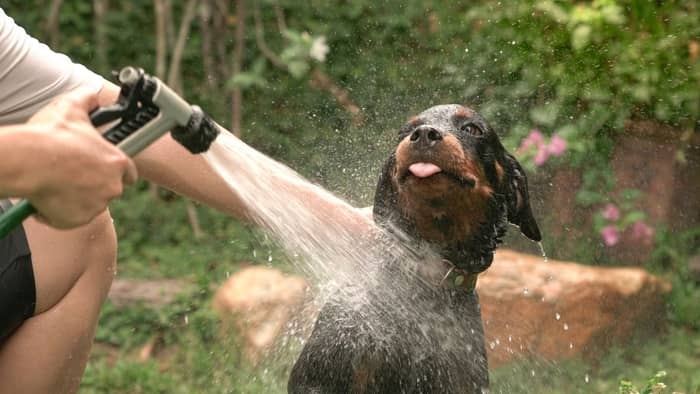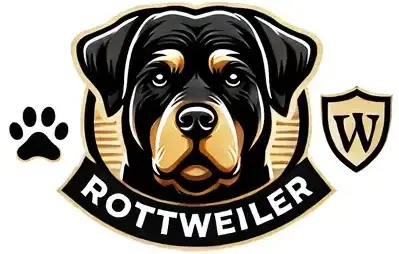Last Updated on April 24, 2024 by Dr. Julie
Do you wonder what to wash a puppy with when they are young and fragile, but you still want to make them look and smell good?
Puppies are cute, cuddly, and full of their personality, but they require a little bit of work, especially when it comes to bathing. Most puppies do not enjoy bath time, and it’s your work to help them enjoy it.
Fortunately, there are many ways to make bath time enjoyable for both you and your puppy. Starting at an early age may help get them used to water at a tender age. Let’s learn what you need to use when washing your delicate little pup.
Table of Contents
What To Wash A Puppy With
Our best advice is to start with lukewarm water and a rag.
There is no need to use harsh cleaning products on your young pup. Use lukewarm water so that it is pleasant to your puppy and you. Ensure the water is not too hot as dogs are sensitive to heat.
Do not use any cleaning products until the puppy is 3 to 4 months. You will be protecting their coat from harsh chemicals that dry it out and cause harmful reactions.
Slowly Graduate To Wash A Puppy With Shampoo.
When your puppy reaches at least 3 months old, it’s time to start using shampoo and conditioner. Select shampoos and conditioners made for dogs and are pH balanced.
Choose those with zero chemical additives and don’t buy the cheapest thing in the market as it could be low quality. Get a specifically designed puppy shampoo that accommodates their sensitive skin and young fur.
Ensure the shampoo is labeled “tearless” because it’s mild and won’t trigger uncomfortable eye irritations to your little pup.
Can You Use Human Shampoo To Wash Your Puppy?
Human shampoos are a no! Never under any circumstances wash your puppy or even a mature dog with human shampoo. The furry friends’ pH levels are nothing like those of the humans.
Using these human shampoos on dogs can lead to skin dryness and itching. Human shampoos end up being too aggressive and overpowering to the dog’s coat and, more so, the puppies. This is the last thing you want to infect your pup with.
Why Use Lukewarm Water?
Water temperature is an essential factor to note before starting to bathe a young puppy.
Ensure the Water is running at a comfortable lukewarm temperature, and allow it to fill the tub to about 3 to 4 inches.
Water that is too hot or too cool may be highly unpleasant for your doggy to sit still and enjoy the bathe. Always opt for lukewarm, regardless of whether your pet is a little puppy or a senior.
Hot water damages the dog’s coat leaving it dry and itchy, while warm water is soothing and keeps their coat smooth and silky.

Learn more about: When Can You Give A Puppy Its First Bath?
Should You Use A Towel To Dry Your Puppy
A towel is essential to use on your puppy after a bath. A clean towel to wrap up your puppy after bath is something your little pup will love. It will help soak up as much excess water as possible.
You can get a pet towel from a pet supplies store that is highly absorbent and made explicitly for dogs’ skin. Sometimes the human towels are too rough and not absorbent enough to take up all the Water.
How Do You Deal With A Puppy That Keeps Slipping In The Tub?
Slipping is a potential hazard to your puppy during bath time. Puppies are rather clumsy during bath time, and the last thing you want is for them to slide all over the tub.
Keep your cute little pup from slipping in the bathtub by laying down a towel or a rubber bathmat to keep them stable.
A stable puppy and some warm water make the bath enjoyable for your new pup.
How Often Should You Bathe A Puppy?
The short answer is not too often. A dog’s coat requires its natural oils to remain soft and silky. It is important to bathe your puppy fewer times to retain its natural oils to keep it from getting damaged or brittle.
Only bathe the dog when you notice it’s dirty or smelly. The time between baths varies between dogs as some are long-haired and gets tangled and matted hair if not bathed frequently, while others have smooth coats.
Tips On How To Give A Puppy A Bath
- Start when your puppy is young and make it fun. This helps your dog get used to the bathing process.
- Choose a specific location for the bathe to take place based on the breed size and time of year. A deep sink or a washtub works best for puppies and small dogs. Big dogs will need a bathtub, or if it’s warm outside, use a hose and have some fun.
- Put a towel or a rubber mat at the bottom of your tub to keep your puppy from slipping all over the surface, and making bathe time frustrating. Your dog will be more secure and settled with the feet firmly planted on the mat or towel.
- Before starting the actual bath, gather all the things you need like shampoo, towels, and possibly a tin or a bucket. Never leave your dog in the Water to grab something unless you want to be involved in a chase with a wet dog all over the house.
- Ensure that your water is lukewarm and only use dog shampoo for the right age. Be sure to get a tearless one to keep all eye irritations away.
- Avoid getting water in your dog’s eyes or ears. Wet your dog’s head last to minimize his desire to shake. Dogs love to shake off Water and might leave you all wet so give them room for that before drying them in towels.
- Rinse your dog’s skin well. Most dogs experience flaky, itchy discomfort due to inadequate shampoo removal or from too frequent baths.
- During winter, keep your dog inside until dry. Use a blow dryer, set on warm or cool, not hot, to avoid burning. This speeds up the dog’s drying time.
- Once you have finished washing your dog, give them instructions to sit/stay before they shake. You may also give them instructions to shake to help them feel satisfied that they are dry but allow space for that cos it will get everything around wet. Give treats afterwards for a good shake and obedience.
Take-Home
Bathing time is an excellent opportunity to check on your dog’s skin. Feel its skin all over for lumps or rough areas.
If any abnormalities are noted, contact your vet immediately. Keep your puppy well groomed as an essential part of happily living together.
